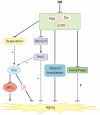Replicative aging in yeast: the means to the end
- PMID: 18616424
- PMCID: PMC2730916
- DOI: 10.1146/annurev.cellbio.23.090506.123509
Replicative aging in yeast: the means to the end
Abstract
Progress in aging research is now rapid, and surprisingly, studies in a single-celled eukaryote are a driving force. The genetic modulators of replicative life span in yeast are being identified, the molecular events that accompany aging are being discovered, and the extent to which longevity pathways are conserved between yeast and multicellular eukaryotes is being tested. In this review, we provide a brief retrospective view on the development of yeast as a model for aging and then turn to recent discoveries that have pushed aging research into novel directions and also linked aging in yeast to well-developed hypotheses in mammals. Although the question of what causes aging still cannot be answered definitively, that day may be rapidly approaching.
Figures





References
-
- Aguilaniu H, Gustafsson L, Rigoulet M, Nystrom T. Asymmetric inheritance of oxidatively damaged proteins during cytokinesis. Science. 2003;299:1751–53. - PubMed
-
- Ahuatzi D, Herrero P, De la Cera T, Moreno F. The glucose-regulated nuclear localization of hexokinase 2 in Saccharomyces cerevisiae is Mig1-dependent. J. Biol. Chem. 2004;279:14440–46. - PubMed
-
- Aparicio OM, Billington BL, Gottschling DE. Modifiers of position effect are shared between telomeric and silent mating-type loci in S. cerevisiae. Cell. 1991;66:1279–87. - PubMed
Publication types
MeSH terms
Grants and funding
LinkOut - more resources
Full Text Sources
Other Literature Sources
Molecular Biology Databases

